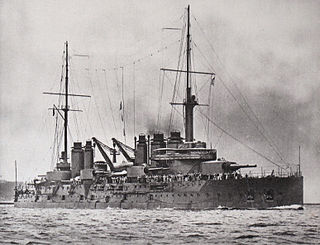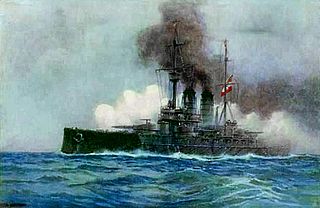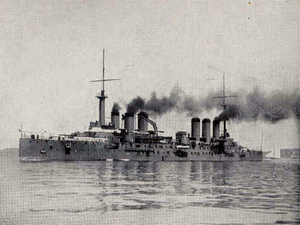
SMS Zrínyi was a Radetzky-class semi-dreadnought battleship (Schlachtschiff) of the Austro-Hungarian Navy, named for the Zrinski, a Croatian-Hungarian noble family. Zrínyi and her sisters, Erzherzog Franz Ferdinand and Radetzky, were the last pre-dreadnoughts built for the Austro-Hungarian Navy.

The armored cruiser was a type of warship of the late 19th and early 20th centuries. It was designed like other types of cruisers to operate as a long-range, independent warship, capable of defeating any ship apart from a battleship and fast enough to outrun any battleship it encountered.

HMS Defence was a Minotaur-class armoured cruiser built for the Royal Navy in the first decade of the 20th century, the last armoured cruiser built for the Royal Navy. She was stationed in the Mediterranean when the First World War began and participated in the pursuit of the German battlecruiser SMS Goeben and light cruiser SMS Breslau. The ship was transferred to the Grand Fleet in January 1915 and remained there for the rest of her career.

Danton was a semi-dreadnought battleship of the French Navy and the lead ship of her class. She was a technological leap in battleship development for the French Navy, as she was the first ship in the fleet with turbine engines. However, like all battleships of her type, she was completed after the Royal Navy battleship HMS Dreadnought, and as such she was outclassed before she was even commissioned.

Condorcet was one of the six Danton-class semi-dreadnought battleships built for the French Navy in the early 1900s. When World War I began in August 1914, she unsuccessfully searched for the German battlecruiser SMS Goeben and the light cruiser SMS Breslau in the Western and Central Mediterranean. Later that month, the ship participated in the Battle of Antivari in the Adriatic Sea and helped to sink an Austro-Hungarian protected cruiser. Condorcet spent most of the rest of the war blockading the Straits of Otranto and the Dardanelles to keep German, Austro-Hungarian and Turkish warships bottled up.

Ernest Renan was an armored cruiser built for the French Navy in the first decade of the 20th century. At the outbreak of World War I in August 1914, she participated in the hunt for the German battlecruiser SMS Goeben and then joined the blockade of the Austro-Hungarian Navy in the Adriatic. She took part in the Battle of Antivari later in August, and the seizure of Corfu in January 1916, but saw no further action during the war. After the war, the British and French intervened in the Russian Civil War; this included a major naval deployment to the Black Sea, which included Ernest Renan. She served as a training ship in the late 1920s before she was sunk as a target ship in the 1930s.

Justice was a pre-dreadnought battleship built for the French Navy in the early 1900s. She was the second member of the Liberté class, which included three other vessels and was a derivative of the preceding République class, with the primary difference being the inclusion of a heavier secondary battery. Justice carried a main battery of four 305 mm (12 in) guns, like the République, but mounted ten 194 mm (7.6 in) guns for her secondary armament in place of the 164 mm (6.5 in) guns of the earlier vessels. Like many late pre-dreadnought designs, Justice was completed after the revolutionary British battleship HMS Dreadnought had entered service, rendering her obsolescent.

Vérité was a pre-dreadnought battleship built for the French Navy in the mid-1900s. She was the second member of the Liberté class, which included three other vessels and was a derivative of the preceding République class, with the primary difference being the inclusion of a heavier secondary battery. Vérité carried a main battery of four 305 mm (12 in) guns, like the République, but mounted ten 194 mm (7.6 in) guns for her secondary armament in place of the 164 mm (6.5 in) guns of the earlier vessels. Like many late pre-dreadnought designs, Vérité was completed after the revolutionary British battleship HMS Dreadnought had entered service and rendered her obsolescent.

Démocratie was a pre-dreadnought battleship built for the French Navy in the mid-1900s. She was the fourth member of the Liberté class, which included three other vessels and was a derivative of the preceding République class, with the primary difference being the inclusion of a heavier secondary battery. Démocratie carried a main battery of four 305 mm (12 in) guns, like the République, but mounted ten 194 mm (7.6 in) guns for her secondary armament in place of the 164 mm (6.5 in) guns of the earlier vessels. Like many late pre-dreadnought designs, Démocratie was completed after the revolutionary British battleship HMS Dreadnought had entered service, rendering her obsolescent.

République was a pre-dreadnought battleship, the lead vessel of the République class built for the French Navy built in the early 1900s. Laid down in December 1901, she was launched in September 1902 and commissioned in January 1907. Armed with a main battery of four 305 mm (12.0 in) guns, she was outclassed before even entering service by the revolutionary British battleship HMS Dreadnought, that had been commissioned the previous December and was armed with a battery of ten guns of the same caliber. Though built to an obsolescent design, République proved to be a workhorse of the French fleet, particularly during World War I.

Patrie was the second and final member of the République class of pre-dreadnought battleships of the French Navy built between her keel laying in April 1902 and her commissioning in July 1907. Armed with a main battery of four 305 mm (12.0 in) guns, she was outclassed before even entering service by the revolutionary British battleship HMS Dreadnought, that had been commissioned the previous December and was armed with a battery of ten guns of the same caliber. Though built to an obsolescent design, Patrie proved to be a workhorse of the French fleet, particularly during World War I.

Waldeck-Rousseau was an armored cruiser built for the French Navy in the first decade of the 20th century. She was the second and final member of the Edgar Quinet class, the last class of armored cruiser to be built by the French Navy. She was laid down at the Arsenal de Lorient in June 1906, launched in March 1908, and commissioned in August 1911. Armed with a main battery of fourteen 194-millimeter (7.6 in) guns, she was more powerful than most other armored cruisers, but she had entered service more than two years after the first battlecruiser—HMS Invincible—had rendered the armored cruiser obsolescent. Waldeck-Rousseau nevertheless proved to be a workhorse of the French Mediterranean Fleet.

SMS Radetzky was the first of the three Radetzky-class pre-dreadnought battleships built for the Austro-Hungarian Navy. She was named for the 19th-century Austrian field marshal Joseph Radetzky von Radetz. Radetzky and her sisters, Erzherzog Franz Ferdinand and Zrínyi, were the last pre-dreadnoughts built by the Austro-Hungarian Navy—they were followed by the larger and significantly more powerful Tegetthoff-class dreadnoughts.

The Battle of Antivari or Action off Antivari was a naval engagement between a large fleet of French and British warships and two ships of the Austro-Hungarian navy at the start of the First World War. The old Austrian protected cruiser SMS Zenta and the destroyer SMS Ulan were blockading the Montenegrin port of Antivari, when on 16 August 1914, they were surprised and cut off by a large Anglo-French force that had sortied into the Adriatic. Zenta fought and was destroyed, to give Ulan a chance to escape, which she did. The ships of the Austrian fleet at Cattaro, unaware of events, did not come out of port to meet the Allied fleet. After blockading the Adriatic for a short while the French were forced to withdraw due to a lack of supplies.

Jurien de la Gravière was a protected cruiser built for the French Navy in the late 1890s and early 1900s, the last vessel of that type built in France. Intended to serve overseas in the French colonial empire, the ship was ordered during a period of internal conflict between proponents of different types of cruisers. She was given a high top speed to enable her to operate as a commerce raider, but the required hull shape made her maneuver poorly. The ship also suffered from problems with her propulsion machinery that kept her from reaching her intended top speed. She carried a main battery of eight 164 mm (6.5 in) guns and was protected by a curved armor deck that was 35–65 mm (1.4–2.6 in) thick.

The Edgar Quinet class was the last type of armored cruiser built for the French Navy. The two ships of this class—Edgar Quinet and Waldeck-Rousseau—were built between 1905 and 1911. They were based on the previous cruiser, Ernest Renan, the primary improvement being a more powerful uniform main battery of 194 mm (7.6 in) guns. The Edgar Quinet class was the most powerful type of armored cruiser built in France, but they entered service more than two years after the British battlecruiser HMS Invincible, which, with its all-big-gun armament, had rendered armored cruisers obsolescent.

SMS Erzherzog Franz Ferdinand was an Austro-Hungarian Radetzky-class pre-dreadnought battleship commissioned into the Austro-Hungarian Navy on 5 June 1910. She was named after Archduke Franz Ferdinand. The first ship of her class to be built, she preceded Radetzky by more than six months. Her armament included four 30.5 cm (12 in) guns in two twin turrets, and eight 24 cm (9.4 in) guns in four twin turrets.

Jules Michelet was an armoured cruiser of the French Navy, laid down in 1904 and completed in 1908. It was a development of the Léon Gambetta class of armoured cruisers, and was the sole representative of its type. It served during the First World War being eventually sunk as a target in 1937.

SMS Kaiser Karl VI was the second of three armored cruisers built by the Austro-Hungarian Navy. She was built by the Stabilimento Tecnico Triestino in Trieste between June 1896 and May 1900, when she was commissioned into the fleet. Kaiser Karl VI represented a significant improvement over the preceding design—Kaiserin und Königin Maria Theresia—being faster and more heavily armed and armored. She provided the basis for the third design, Sankt Georg, which featured further incremental improvements. Having no overseas colonies to patrol, Austria-Hungary built the ship solely to reinforce its battle fleet.

The Canon de 194 mm Modèle 1902 was a medium-caliber naval gun used as the primary or secondary armament in both casemates and turrets of a number of French pre-dreadnoughts and armored cruisers during World War I. After World War I these ships were scrapped and some were later reused as coastal artillery in World War II
























